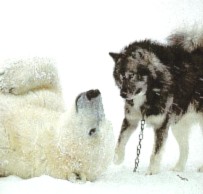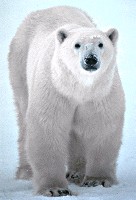 Polar bears are the world's largest land predators. They live in the Arctic, in the northern regions of Alaska, Canada, Russia, Greenland, and Norway. Polar bears are the world's largest land predators. They live in the Arctic, in the northern regions of Alaska, Canada, Russia, Greenland, and Norway.
Adult male polar bears weigh on average 1000 pounds, and can weigh up to 1500 pounds. females are considerably smaller, normally weighing up to 500 pounds. An adult polar bear's only enemies are humans, and occasionally other polar bears. In the wild, adult polar bears live an average of 15 to 18 years, though biologists have found a few that have lived to 30. In zoos, many captive bears live until their late 30s. The polar bear's diet consists mostly of the ringed seal. In winter, polar bears capture these seals by waiting near the seal's breathing hole. When the seal comes up for air, the polar bear grabs it. In summer, the bears sneak up on seals while they're sleeping on the ice ... the bear crawls slowly forward when the seal sleeps, and freezes in place when the animal raises its head. When close enough, the polar bear pounces, killing the seal before it can escape back into the sea. When a polar bear is sneaking up on a seal, it will often get down low to the ice so that its white fur blends in with the snowy background. The only part of the bear the seal can clearly see is its black nose ... which the seal mistakes for another seal far away. 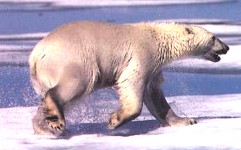 The polar bear is the only bear to be considered a marine mammal. Polar bears spend as much time on the ice and in the water as they do on land, and are excellent swimmers; they have been known to swim over 50 miles, at the sedate speed of six miles per hour. A polar bear's front paws are partially webbed and very large, to help it swim better. Fur between the pads help the bear sneak up quietly on its prey. The polar bear's fat layer, which is three to four inches thick, not only protects it from the cold, but gives it buoyancy in the water. Polar bears use their layer of fat to protect them from the cold air and cold water. Walrus, whales and seals also have layers of blubber, which help to keep them warm. The polar bear's fat layer is 4-5 inches thick, and is so effective that adult males quickly overheat when they run. Here's an interesting experiment you can do, to learn how good an insulator fat is ... visit our blubber experiment page. Because of their well-insulated body, polar bears give off no detectable heat; ... they don't even show up in infrared photographs. (Infrared film measures heat.) When a scientist attempted to photograph a bear with such film, he produced a print with a single spot ... the puff of air caused by the animal's breath! The bear's fur also helps keep it warm in an unusual way. Younger bears have fur that looks white (because of the refraction of light), but is actually translucent. Individual hairs act as 'light pipes', conducting light energy down to the skin, which is dark. As bears age, the fur begins to take on a slight yellowish colour due to continued exposure to sunlight. 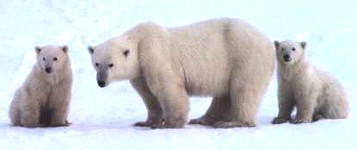 Polar Bear Cubs:
Polar Bear Cubs:
A female usually has two cubs. The mother gives birth to her cubs about two months after she enters the den in the fall. Newborns are about a foot long. Half of all cubs die in their first year, due to starvation, killing by hunters, or accidents. Polar bear cubs drink their mother's milk for almost 2 years, and depend on her for survival. As with most bears, the male may kill the cubs, although highly protective mothers are capable of driving off much larger males. Polar bears have distinct territories; a polar bear's home range can be enormous, far greater than that of any other bear. A single polar bear may rove across an area twice as big as the country of Iceland. Young polar bears may travel more than 1,000 kilometers (600 miles) to set up a home range apart from their mother's. However, there are distinct groupings of polar bears in the arctic regions around the world, and bears tend to stay within their own group's region, near their denning areas and the seals. The polar bear's sense of direction is phenomenal, and quite mysterious. It can unerringly find its way across the ice of frozen seas that are constantly breaking up and refreezing, and where there can be no recognizable landmarks. The polar bear, like brown and black bears, does not truly 'hibernate'. Though their heart rate slows, their body temperature does not drop dramatically, and while they may sleep, they have no difficulty waking up. Though brown and black bears sleep in winter, male polar bears do not. Only pregnant females spend the winter sleeping in a den, a two-chambered tunnel scraped into the snow. The female gives birth to her cubs late in the year. Polar bears are very intelligent, which can be seen in the various ways they stalk seals. A bear may drift in the water toward a seal on an ice floe, with only its head visible, mimicing a chunk of ice; when it gets close enough, it leaps out of the water and hits the seal with a paw. Polar bears have been observed to scrape the ice layer at a seal's breathing hole until it is paper thin, and then lie on top of the hole to simulate snow cover; the unsuspecting seal will surface right under the bear. Bears will also build a snow wall to hide behind as they wait for a seal to surface at a hole. Polar Bear Survival: Polar bears are a potentially threatened species. Because they live in and move through more than one country in the north, there is no single protection scheme to keep their numbers safe. 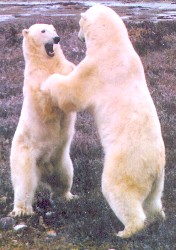 In Norway, polar bears are completely protected, but scientists are worried about the effects of pollution on the bears. PCB levels in the polar bears of Norway and western Russia are two-and-a-half to seventeen times higher than those in North American populations. In Canada, Hudson Bay's ice melts about three weeks earlier each spring than it did just 25 years ago, which has greatly shortened the time that the bears can hunt for food. (Polar bears need a platform of ice from which to hunt seals.) Canadian scientists have observed that today's polar bears are smaller in stature, weigh less, and have fewer cubs. The bears in certain areas of Canada have excessive levels of PCBs and other contaminants. Native hunting is allowed. Each community is given a quota, and natives are permitted to sell their right to hunt a bear to non-natives. Roughly 500 bears are killed each year. In Alaska, about 100 polar bears are killed every year by natives. The only restriction is that if they kill a bear, the carcass must be used in some way. Natives are not allowed to sell the skins, but may make and sell products from them. In Greenland, which is governed by Denmark, natives may hunt polar bears, but are forbidden from selling any bear parts. About 100 bears are killed each year. In Russia, polar bears may be in danger. Russian natives were recently granted the right to hunt, and the breakdown of law and order and the collapse of the Russian economy has led to widespread poaching problems. It is thought that legal hunting will encourage further poaching. Polar bears in western Russia are exposed to dangerously high levels of pollutants.
|

